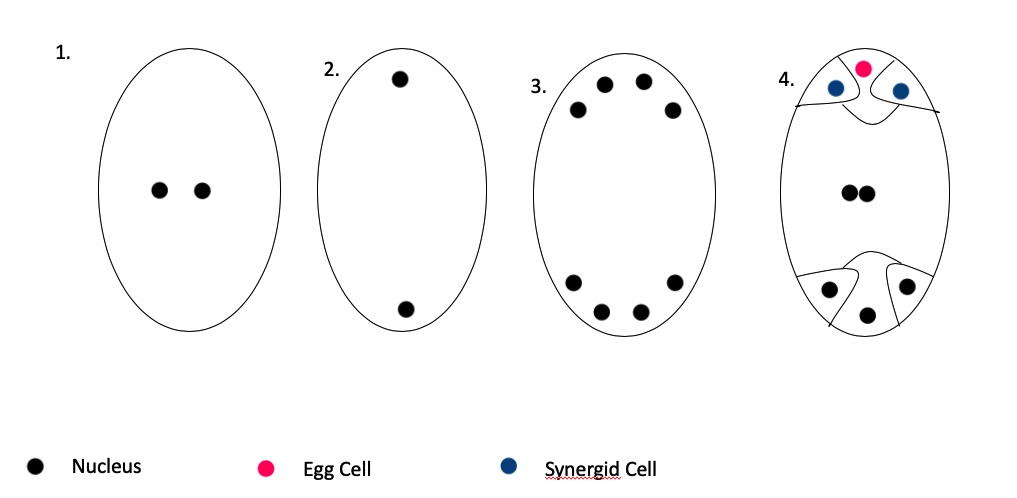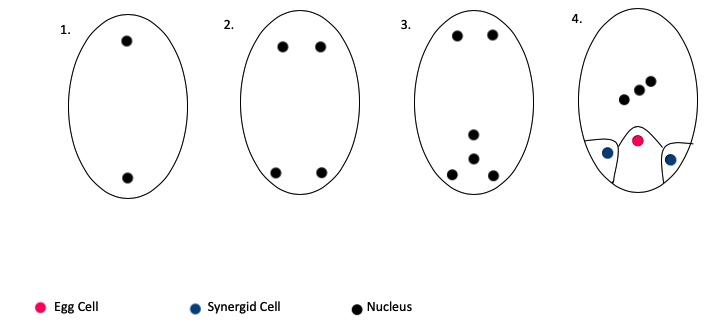megagametogenesis on:
[Wikipedia]
[Google]
[Amazon]
Megagametogenesis is the process of maturation of the female gametophyte, or megagametophyte, in plants During the process of megagametogenesis, the megaspore, which arises from megasporogenesis, develops into the embryo sac, which is where the female gamete is housed. These megaspores then develop into the haploid female gametophytes. This occurs within the ovule, which is housed inside the ovary.
 Prior to megagametogenesis, a developing embryo undergoes meiosis during a process called megasporogenesis. Next, three out of four megaspores disintegrate, leaving only the megaspore that will undergo the megagametogenesis. The following steps are shown in Figure 1, and detailed below.
# The remaining megaspore undergoes a round of mitosis. This results in a structure with two nuclei, also called a binucleate embryo sac.
# The two nuclei migrate to opposite sides of the embryo sac.
# Each haploid nucleus then undergoes two rounds of mitosis which creates 4 haploid nuclei on each end of the embryo sac.
# One nucleus from each set of 4 migrates to the center of the embryo sac. These form the binucleate endosperm mother cell. This leaves three remaining nuclei on the micropylar end and three remaining nuclei on the antipodal end. The nuclei on the micropylar end is composed of an egg cell, two synergid cells, and the micropyle, an opening that allows the pollen tube to enter the structure. The nuclei on the antipodal end are simply known as the antipodal cells. These cells are involved with nourishing the embryo, but often undergo programmed cell death before fertilization occurs.
# Cell plates form around the antipodal nuclei, egg ell, and synergid cells.
Prior to megagametogenesis, a developing embryo undergoes meiosis during a process called megasporogenesis. Next, three out of four megaspores disintegrate, leaving only the megaspore that will undergo the megagametogenesis. The following steps are shown in Figure 1, and detailed below.
# The remaining megaspore undergoes a round of mitosis. This results in a structure with two nuclei, also called a binucleate embryo sac.
# The two nuclei migrate to opposite sides of the embryo sac.
# Each haploid nucleus then undergoes two rounds of mitosis which creates 4 haploid nuclei on each end of the embryo sac.
# One nucleus from each set of 4 migrates to the center of the embryo sac. These form the binucleate endosperm mother cell. This leaves three remaining nuclei on the micropylar end and three remaining nuclei on the antipodal end. The nuclei on the micropylar end is composed of an egg cell, two synergid cells, and the micropyle, an opening that allows the pollen tube to enter the structure. The nuclei on the antipodal end are simply known as the antipodal cells. These cells are involved with nourishing the embryo, but often undergo programmed cell death before fertilization occurs.
# Cell plates form around the antipodal nuclei, egg ell, and synergid cells.
 The most common type of megagametogenesis, monosporic megagametogenesis, is outlined above. This type of megagemetogenesis only allows one megaspore to undergo megagametogenesis, while the other three undergo programmed cell death.
The most common type of megagametogenesis, monosporic megagametogenesis, is outlined above. This type of megagemetogenesis only allows one megaspore to undergo megagametogenesis, while the other three undergo programmed cell death.
The Process
 Prior to megagametogenesis, a developing embryo undergoes meiosis during a process called megasporogenesis. Next, three out of four megaspores disintegrate, leaving only the megaspore that will undergo the megagametogenesis. The following steps are shown in Figure 1, and detailed below.
# The remaining megaspore undergoes a round of mitosis. This results in a structure with two nuclei, also called a binucleate embryo sac.
# The two nuclei migrate to opposite sides of the embryo sac.
# Each haploid nucleus then undergoes two rounds of mitosis which creates 4 haploid nuclei on each end of the embryo sac.
# One nucleus from each set of 4 migrates to the center of the embryo sac. These form the binucleate endosperm mother cell. This leaves three remaining nuclei on the micropylar end and three remaining nuclei on the antipodal end. The nuclei on the micropylar end is composed of an egg cell, two synergid cells, and the micropyle, an opening that allows the pollen tube to enter the structure. The nuclei on the antipodal end are simply known as the antipodal cells. These cells are involved with nourishing the embryo, but often undergo programmed cell death before fertilization occurs.
# Cell plates form around the antipodal nuclei, egg ell, and synergid cells.
Prior to megagametogenesis, a developing embryo undergoes meiosis during a process called megasporogenesis. Next, three out of four megaspores disintegrate, leaving only the megaspore that will undergo the megagametogenesis. The following steps are shown in Figure 1, and detailed below.
# The remaining megaspore undergoes a round of mitosis. This results in a structure with two nuclei, also called a binucleate embryo sac.
# The two nuclei migrate to opposite sides of the embryo sac.
# Each haploid nucleus then undergoes two rounds of mitosis which creates 4 haploid nuclei on each end of the embryo sac.
# One nucleus from each set of 4 migrates to the center of the embryo sac. These form the binucleate endosperm mother cell. This leaves three remaining nuclei on the micropylar end and three remaining nuclei on the antipodal end. The nuclei on the micropylar end is composed of an egg cell, two synergid cells, and the micropyle, an opening that allows the pollen tube to enter the structure. The nuclei on the antipodal end are simply known as the antipodal cells. These cells are involved with nourishing the embryo, but often undergo programmed cell death before fertilization occurs.
# Cell plates form around the antipodal nuclei, egg ell, and synergid cells.
Variations
Plants exhibit three main types of megagametogenesis. The number of haploid nuclei in the functional megaspore that is involved in megagametogenesis is the main difference between these three types.Monosporic
 The most common type of megagametogenesis, monosporic megagametogenesis, is outlined above. This type of megagemetogenesis only allows one megaspore to undergo megagametogenesis, while the other three undergo programmed cell death.
The most common type of megagametogenesis, monosporic megagametogenesis, is outlined above. This type of megagemetogenesis only allows one megaspore to undergo megagametogenesis, while the other three undergo programmed cell death.
Bisporic
As the name implies, bisporic megagametogenesis involves two genetically different haploid nuclei. # These two nuclei undergo a round of mitosis. # Then, the nuclei on the micropylar end of the structure undergo a second round of mitosis. # Next, the nuclei rearrange to form a trinucleate endosperm mother cell and the characteristic arrangement of the micropylar end, with an egg cell and two synergid cells. # Cell plates form around the egg cell and synergid cells.Eudicots
Ineudicot
The eudicots, Eudicotidae, or eudicotyledons are a clade of flowering plants mainly characterized by having two seed leaves upon germination. The term derives from Dicotyledons.
Traditionally they were called tricolpates or non-magnoliid dicots ...
plants, the entire process happens inside the ovule
In seed plants, the ovule is the structure that gives rise to and contains the female reproductive cells. It consists of three parts: the ''integument'', forming its outer layer, the ''nucellus'' (or remnant of the megasporangium), and the fem ...
of a plant. The details of the process vary by species, but the process described here is common. This process starts with a single diploid
Ploidy () is the number of complete sets of chromosomes in a cell, and hence the number of possible alleles for autosomal and pseudoautosomal genes. Sets of chromosomes refer to the number of maternal and paternal chromosome copies, respectiv ...
megasporocyte in the nucleus. This megasporocyte undergoes meiotic
Meiosis (; , since it is a reductional division) is a special type of cell division of germ cells in sexually-reproducing organisms that produces the gametes, such as sperm or egg cells. It involves two rounds of division that ultimately res ...
cell division to form four cells that are haploid
Ploidy () is the number of complete sets of chromosomes in a cell, and hence the number of possible alleles for autosomal and pseudoautosomal genes. Sets of chromosomes refer to the number of maternal and paternal chromosome copies, respecti ...
. Three cells die and one that is most distant from the micropyle develops into the megaspore. This megaspore becomes larger and the nucleus of it undergoes mitosis
In cell biology, mitosis () is a part of the cell cycle in which replicated chromosomes are separated into two new nuclei. Cell division by mitosis gives rise to genetically identical cells in which the total number of chromosomes is maint ...
three times until there are eight nuclei. These eight nuclei are then arranged into two groups of four. These groups both send a nucleus to the center of the cell which then becomes the polar nuclei. The three cells left at the end of the cell near the micropylar become the egg apparatus with an egg cell in the center and two synergids. A cell wall forms around the other set of nuclei and forms the antipodals. The cells in the center develop into the central cell. This entire structure with its eight nuclei is called the embryo sac.
Post-megagametogenesis
Megagametogenesis creates the female gametophyte, which is an integral part of pollination, a very prominent process in plants. The male counterpart to megagametogenesis is called microgametogenesis. Microgametogenesis is the process of the formation of the male gametophyte. During pollination, the female gametophyte communicates with the pollen tube to ensure that it comes in contact with the ovule. When contact is made, the pollen tube grows through the micropyle opening into a synergid cell, that dies when this occurs. The death of the synergid cell signals to the pollen tube to release the sperm. This process creates the embryo, seed coat, and endosperm which, after pollination, will become crucial parts of the seed.Implications
Pollination is an essential process of global crop production. Its success is economically crucial for farmers. Additionally, pollination success is required for global food security. Cereals, or the seeds of grain crops, are most important staple food to humans around the world. They make up 48% of the calories consumed by humans.See also
*Megaspore
Megaspores, also called macrospores, are a type of spore that is present in heterosporous plants. These plants have two spore types, megaspores and microspores. Generally speaking, the megaspore, or large spore, germinates into a female gametophy ...
— it is the female part of the flower in which seeds are formed. it consists of 7 parts: funicle, hilam, integuments, micropyle, chalaza, nucellus, embryosac
* Microspore
Microspores are land plant spores that develop into male gametophytes, whereas megaspores develop into female gametophytes. The male gametophyte gives rise to sperm cells, which are used for fertilization of an egg cell to form a zygote. Megaspor ...
— it is the male part of the flower in which pollen grains are stored.
* Gametophyte
A gametophyte () is one of the two alternating multicellular phases in the life cycles of plants and algae. It is a haploid multicellular organism that develops from a haploid spore that has one set of chromosomes. The gametophyte is the se ...
References
Further reading
* {{refend Reproduction